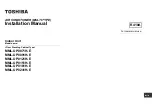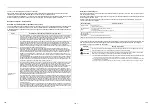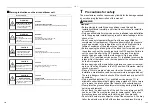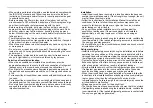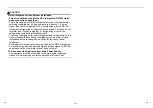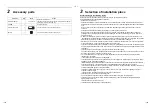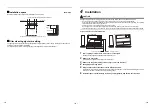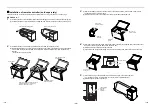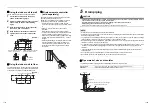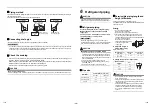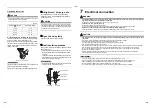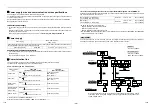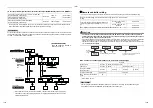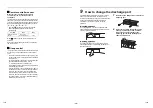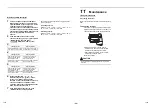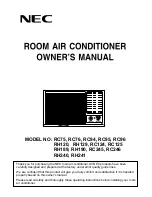
– 5 –
Electrical wiring
• Only a qualified installer (*1) or qualified service person (*1) is
allowed to carry out the electrical work of the air conditioner. Under
no circumstances must this work be done by an unqualified individual
since failure to carry out the work properly may result in electric
shocks and/or electrical leaks.
• To connect the electrical wires, repair the electrical parts or undertake
other electrical jobs, wear gloves to provide protection for electricians
and from heat, insulating shoes and clothing to provide protection
from electric shocks. Failure to wear this protective gear may result in
electric shocks.
• Use wiring that meets the specifications in the Installation Manual and
the stipulations in the local regulations and laws. Use of wiring which
does not meet the specifications may give rise to electric shocks,
electrical leakage, smoking and/or a fire.
• Be sure to connect earth wire. (Grounding work)
Incomplete grounding causes an electric shock.
• Do not connect earth wires to gas pipes, water pipes, and lightning
conductor or telephone earth wires.
• After completing the repair or relocation work, check that the earth
wires are connected properly.
• Install a circuit breaker that meets the specifications in the installation
manual and the stipulations in the local regulations and laws.
• Install the circuit breaker where it can be easily accessed by the
agent.
• When installing the circuit breaker outdoors, install one which is
designed to be used outdoors.
• Under no circumstances the power wire must not be extended.
Connection trouble in the places where the wire is extended may give
rise to smoking and/or a fire.
• Electrical wiring work shall be conducted according to law and
regulation in the community and installation manual.
Failure to do so may result in electrocution or short circuit.
Test run
• Before operating the air conditioner after having completed the work,
check that the electrical control box cover of the indoor unit and
service panel of the outdoor unit are closed, and set the circuit
breaker to the ON position. You may receive an electric shock if the
power is turned on without first conducting these checks.
• If there is any kind of trouble (such as check code display has
appeared, smell of burning, abnormal sounds, the air conditioner fails
to cool or heat or water is leaking) has occurred in the air conditioner,
do not touch the air conditioner yourself but set the circuit breaker to
the OFF position, and contact a qualified service person. Take steps
to ensure that the power will not be turned on (by marking “out of
service” near the circuit breaker, for instance) until qualified service
person arrives. Continuing to use the air conditioner in the trouble
status may cause mechanical problems to escalate or result in
electric shocks or other trouble.
• After the work has finished, use an insulation tester set (500 VM
Ω
) to
check the resistance is 1 M
Ω
or more between the charge section and
the non-charge metal section (Earth section). If the resistance value
is low, a disaster such as a leak or electric shock is caused at user’s
side.
• Upon completion of the installation work, check for refrigerant leaks
and check the insulation resistance and water drainage. Then
conduct a test run to check that the air conditioner is operating
properly.
Explanations given to user
• Upon completion of the installation work, tell the user where the circuit
breaker is located. If the user does not know where the circuit breaker
is, he or she will not be able to turn it off in the event that trouble has
occurred in the air conditioner.
• After the installation work, follow the Owner’s Manual to explain to the
customer how to use and maintain the unit.
Relocation
• Only a qualified installer (*1) or qualified service person (*1) is
allowed to relocate the air conditioner. It is dangerous for the air
conditioner to be relocated by an unqualified individual since a fire,
electric shocks, injury, water leakage, noise and/or vibration may
result.
• When carrying out the pump-down work shut down the compressor
before disconnecting the refrigerant pipe. Disconnecting the
refrigerant pipe with the service valve left open and the compressor
still operating will cause air or other gas to be sucked in, raising the
pressure inside the refrigeration cycle to an abnormally high level,
and possibly resulting in rupture, injury or other trouble.
(*1) Refer to the “Definition of qualified installer or qualified service person”.
9-EN
10-EN
Содержание MML-UP0071H-E
Страница 30: ...EB99841101 ...

